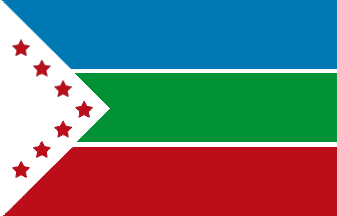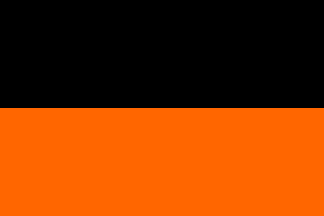 image by Fred Drews, 21 March 2020
image by Fred Drews, 21 March 2020
Last modified: 2020-04-19 by rob raeside
Keywords: zarcero | alajuela | alfaro ruiz |
Links: FOTW homepage |
search |
disclaimer and copyright |
write us |
mirrors
 image by Fred Drews, 21 March 2020
image by Fred Drews, 21 March 2020
See also:
Zarcero Canton (10,726 inhabitants in 2010; 15,513 ha) was established by Law
No. 27 of 21 June 1915, as the 11th canton in Alajuela
Province; the new canton was formerly the 4th district of
Naranjo Canton, itself established by Decree No. 2 of 9 March 1886. The
canton was originally named Alfaro Ruiz, for a hero of the Campaign of
1856-1857. On 16 June 2010, the canton was renamed Zarcero, for its capital
town, as it was already better known at the national and international
level.Zarcero Canton is made of seven districts : Zarcero (including the
villages of Santa Teresita and Zarcero), Laguna (incl. La Pena), Tapezco,
Palmira (incl. Palmira and Pueblo Nuevo), Guadalupe (incl. Anateri, Guadalupe
and San Luis), Zapote (incl. Lajas and Santa Elena) and Las Brisas (incl. La
Legua, Santa Rosa and Los Ángeles [Bajo Tapezco]. While the first five districts
of the list date back to the canton's foundation, Zapote and Las Brisas were
established in 1939 and 1998, respectively.
Source: Cantonal website
Ivan Sache, 21 July 2013
The flag of Zarcero is prescribed by a Municipal Decree No. 399, adopted on 1
July 2013 by the Municipal Council and signed on 8 July 2013 by the Mayor. The
flag is horizontally divided celeste blue-green-winey red, the stripes being
separated by a thin white fimbriation. Along the hoist is placed a white
triangle charged with seven red stars lined along the inner sides of the
triangle.
Celeste blue represents the sky and the water resources of the canton. Green
symbolizes the mountains, the fertile fields, agriculture, aspiration to an
abundant life in our natural environment, and growth. Green also represents
health as well as equilibrium and harmony with the environment. Combined with
celeste blue, green evokes re-emergence and renovation. Green also represents
the cypress trees that enjoys the visitor's view and release a pleasant flavour,
even when not fructed.
Winey red recalls the historical origin of the canton's name, which refers to
sarsaparille (aka rough binweed, "Smilax aspera".; in Spanish, "zarzaparrilla"
or "zarzamora"), once common in the canton. The fruit of sarsaparille turn from
bright red to winey red during ripening. Winey red also recalls the colour of
the cheeks of the locals, caused by the cold local climate and the frequent
trade winds. Winey red represents the colour of the criollo peach. White is a
symbol of purity, limpidity and innocence.The seven stars on the white triangle
represent the seven districts united in peace, tranquillity and solidarity.
White also represents the white clouds common during the rainy season.
The width of the triangle is 1/3 of the flag's width. The height of each colour
stripe is 33.3% of the flag's height.
The colours are prescribed as:
- Celeste blue: Pantone P 121-16C;
- Green: Pantone P 151 - 16C;
- Winey red: Pantone P 49 - 16 C.
[These odd prescriptions do not appear to match genuine Pantone codes.]
Sources: Flag
page, cantonal website and
Decree No. 399, cantonal website
Ivan Sache, 21 July 2013

image by Ivan Sache, 21 July 2013
The [current] flag was selected through a public contest, set up to replace
the flag previously sued; horizontally divided black-orange, this flag was
turned down because there was no genuine reference explaining the origin of the
colours.The proposals were expected to represent all the settlements forming the
canton. The use of colours and/or elements representing the peach flower and the
leaves and fruit of sarsaparille was suggested. The proposals should include no
more than four colours, with the explanation given for each of them. The
deadline for proposal submission was 7 June 2013
Sources:
Contest
announcement, cantonal website and a
Facebook message, dated 15 July
2013, claims that the flag was designed by merging the two proposals that won
the contest.
Ivan Sache, 21 July 2013
a-02.gif)
image contributed by Fred Drews, 23 March 2006